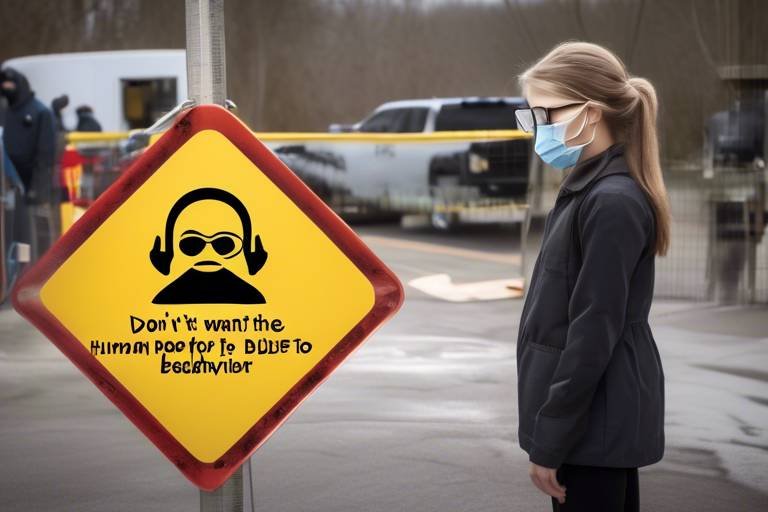Launching Safety Protocols Based on Human Behavior Understanding
In today's fast-paced world, the safety of individuals in various environments has become a top priority. However, traditional safety protocols often overlook a critical element: human behavior. By integrating insights from behavioral science into safety protocols, organizations can enhance their effectiveness and ensure better compliance. This article explores the significance of understanding human behavior in launching safety protocols that resonate with the real-world actions and reactions of individuals. We will delve into various aspects of this approach, from motivation to risk perception, and how these factors can create a safer environment for everyone.
To truly grasp the essence of safety, we must first understand how human behavior influences safety practices. People do not always act in ways that align with established protocols, often due to a lack of understanding or perceived irrelevance of the rules. By acknowledging the real-world actions and reactions of individuals, we can develop safety protocols that resonate more deeply with them. For instance, consider a workplace where employees are required to wear safety helmets. If they perceive the risk of head injury as minimal, they may not comply with the helmet requirement. Thus, understanding the psychological factors that drive behavior is essential for creating effective safety measures.
Several psychological principles underpin human behavior, and understanding these can significantly enhance the effectiveness of safety protocols. Key concepts include motivation, perception, and decision-making. By leveraging these principles, organizations can design protocols that not only inform but also inspire compliance. For instance, if employees are intrinsically motivated to prioritize safety, they are more likely to adhere to protocols. This intrinsic motivation can stem from a genuine concern for their own well-being or the well-being of their colleagues.
Motivation plays a pivotal role in ensuring compliance with safety protocols. There are two primary types of motivation: intrinsic and extrinsic. Intrinsic motivation arises from within the individual, driven by personal values or beliefs, while extrinsic motivation is influenced by external factors such as rewards or recognition. Understanding these motivators allows organizations to tailor their safety protocols effectively. For example, an organization might implement a reward system for teams that consistently adhere to safety measures, thus enhancing extrinsic motivation.
When analyzing motivation, it’s crucial to differentiate between intrinsic and extrinsic factors. Intrinsic motivation often leads to more sustainable behavior change because it aligns with personal values. On the other hand, extrinsic motivation can be powerful but may not result in lasting compliance if the external rewards are removed. Therefore, safety protocols should aim to foster both types of motivation, creating a culture where safety is valued both personally and collectively.
To promote adherence to safety protocols, organizations can utilize various behavioral reinforcement techniques. These may include recognition programs, where employees are publicly acknowledged for their commitment to safety, or tangible rewards, such as bonuses for teams that meet safety compliance metrics. By reinforcing positive behaviors, organizations can cultivate a culture of safety that encourages individuals to consistently follow protocols.
Another critical factor in safety behavior is how individuals perceive risk. People often have differing views on what constitutes a risk, influenced by personal experiences and societal norms. For example, someone who has never experienced a workplace accident may underestimate the importance of following safety protocols. Therefore, it is essential that safety protocols are designed to address these perceptions effectively, perhaps through training that highlights the real consequences of neglecting safety measures.
Incorporating behavioral insights into the development of safety protocols can lead to more user-friendly and relatable measures. By understanding how individuals interact with safety guidelines, organizations can identify areas for improvement and create protocols that resonate with employees. This approach not only enhances compliance but also fosters a sense of ownership among individuals regarding their safety practices.
To gather valuable data on how individuals engage with safety protocols, organizations should conduct behavioral research. This can involve surveys, interviews, or observational studies that explore employees' interactions with safety measures. By analyzing this data, organizations can pinpoint specific barriers to compliance and tailor their protocols accordingly.
Implementing safety protocols is not a one-time event; it requires ongoing testing and iteration based on behavioral feedback. Organizations should regularly assess the effectiveness of their protocols and make adjustments as needed to ensure they remain relevant and effective in promoting safety.
Training and education are vital components in reinforcing safety protocols. It is essential that individuals understand not just the how but also the why behind safety measures. This deeper understanding can foster a more profound commitment to compliance and create a culture of safety within the organization.
To convey safety protocols clearly and effectively, organizations should employ various communication strategies. This may include visual aids, workshops, and regular updates that engage all stakeholders. Clear communication ensures that everyone understands their roles and responsibilities concerning safety protocols.
Simulations and role-playing can serve as powerful training tools, enhancing understanding and retention of safety protocols. By immersing individuals in realistic scenarios, they can practice their responses to potential safety hazards, thereby reinforcing their commitment to safety.
Finally, evaluating the effectiveness of safety protocols is crucial for continuous improvement. Organizations can employ various metrics to measure compliance and behavior change, ensuring that safety measures adapt to the evolving needs of the workforce.
Implementing feedback mechanisms allows organizations to assess protocol effectiveness and gather insights for future enhancements. Regular feedback from employees can highlight areas for improvement and foster a culture of open communication regarding safety practices.
Conducting long-term assessments is essential to measure the sustained impact of safety protocols on behavior and overall safety outcomes. By analyzing data over time, organizations can determine the effectiveness of their safety measures and make informed decisions for future improvements.
- Why is understanding human behavior important in safety protocols? Understanding human behavior helps create protocols that resonate with individuals, leading to better compliance and a safer environment.
- What are intrinsic and extrinsic motivations? Intrinsic motivation comes from within, driven by personal values, while extrinsic motivation is influenced by external rewards or recognition.
- How can organizations gather behavioral insights? Organizations can conduct surveys, interviews, and observational studies to understand how individuals interact with safety protocols.
- What role does training play in safety protocols? Training ensures individuals understand both the 'how' and 'why' of safety measures, fostering a culture of compliance and safety awareness.

Understanding Human Behavior in Safety
When it comes to safety protocols, understanding human behavior is not just an option; it's a necessity. Think about it: how many times have you seen safety rules being ignored or misunderstood? This disconnect often stems from a lack of insight into how people actually think and behave in real-world situations. Safety measures should resonate with individuals, aligning with their natural instincts and reactions. If safety protocols are designed without considering human behavior, they risk becoming mere checkboxes that people overlook.
For instance, consider a workplace setting where employees are required to wear safety gear. If the protocols are rigid and do not account for the daily realities of the workers—like discomfort or impracticality—compliance will likely suffer. This is where an understanding of human behavior becomes crucial. By observing and analyzing how people interact with safety measures, organizations can develop protocols that are not only effective but also engaging and relatable.
Moreover, the environment plays a significant role in shaping behavior. Different settings can evoke various responses. For example, a construction site might see a different compliance rate compared to an office environment. This variance highlights the need for tailored safety protocols that consider the specific context in which they are applied. By integrating insights from behavioral science, organizations can create a safety culture that encourages individuals to prioritize their well-being and that of their colleagues.
Understanding human behavior in safety also involves recognizing the emotional and psychological factors at play. People are not robots; they have feelings, fears, and motivations. Acknowledging these aspects can lead to more effective communication strategies that resonate with individuals on a deeper level. For instance, instead of merely stating the rules, safety briefings can incorporate stories or scenarios that illustrate the real-life consequences of neglecting safety measures. This storytelling approach can evoke empathy and a sense of responsibility, making the message more impactful.
In summary, integrating human behavior insights into safety protocols is essential for creating a safer environment. It requires a shift from viewing safety as a set of rules to understanding it as a dynamic interaction between people and their surroundings. By doing so, organizations can foster a culture of safety that not only protects individuals but also empowers them to take charge of their own safety and that of others.

Key Psychological Principles
When it comes to safety protocols, understanding the psychological principles that drive human behavior is crucial. These principles not only inform how individuals respond to safety measures but also shape the effectiveness of those protocols. By diving into the realms of motivation, perception, and decision-making, we can create safety systems that resonate with real-world actions and reactions.
Let's start with motivation. This is the fuel that drives individuals to comply with safety measures. It’s essential to recognize that not all motivations are created equal. Some people are driven by intrinsic motivators, such as personal pride or a sense of responsibility, while others may respond better to extrinsic motivators, like rewards or recognition. Understanding this distinction can help in designing safety protocols that not only encourage compliance but also foster a culture of safety.
For instance, consider a workplace scenario where employees are encouraged to wear safety gear. If the motivation is purely extrinsic, such as a bonus for compliance, employees may adhere to the rules only as long as the incentive exists. However, if they develop an intrinsic motivation—understanding the importance of safety for themselves and their colleagues—they are more likely to make it a lasting habit. This is where the magic happens; when compliance transitions from a requirement to a personal choice, safety becomes a shared value.
To further illustrate, let’s break down the differences:
| Type of Motivation | Description | Examples |
|---|---|---|
| Intrinsic | Driven by internal satisfaction and personal values. | Feeling proud of following safety protocols, wanting to protect coworkers. |
| Extrinsic | Driven by external rewards or pressures. | Receiving bonuses for compliance, avoiding penalties. |
Next, we have the perception of risk, which plays a pivotal role in how individuals behave in potentially hazardous situations. People often have varied perceptions of risk based on their experiences, knowledge, and even emotional responses. For example, someone who has witnessed an accident may perceive a certain task as highly risky, while another person might view it as safe. This discrepancy can lead to inconsistent adherence to safety protocols.
To address these perceptions effectively, safety protocols need to be designed with a clear understanding of how individuals interpret risk. By providing contextual information and relatable scenarios, we can help individuals reassess their perceptions and encourage safer behaviors. This might involve training sessions that highlight real-life incidents or simulations that allow individuals to experience the consequences of unsafe actions.
Incorporating behavioral insights into the development of safety protocols is not just beneficial; it's essential. By recognizing the psychological principles outlined above, organizations can create safety systems that are not only effective but also user-friendly. This means protocols that individuals can easily relate to and understand, ultimately leading to higher compliance rates.
In conclusion, understanding key psychological principles such as motivation and perception is fundamental to developing effective safety protocols. By leveraging these insights, we can create environments where safety is prioritized and ingrained in the culture. After all, when individuals feel motivated and perceive safety as a shared responsibility, everyone wins.
- What is the importance of understanding human behavior in safety protocols?
Understanding human behavior helps tailor safety protocols to be more effective and relatable, ensuring better compliance and a safer environment. - How can motivation influence compliance with safety protocols?
Motivation, whether intrinsic or extrinsic, plays a crucial role in whether individuals choose to adhere to safety measures or not. - What are some effective ways to change perceptions of risk?
Providing contextual information, relatable scenarios, and engaging training can help individuals reassess their perceptions of risk.

Motivation and Compliance
When it comes to safety protocols, one of the most critical factors that can determine their success is the motivation of individuals to comply with them. Think about it: if people don't feel compelled to follow safety measures, even the most robust protocols can fall flat. So, how do we ignite that spark of motivation? It’s all about understanding the different types of motivators that can drive behavior.
At the core of motivation are two main types: intrinsic and extrinsic. Intrinsic motivation comes from within. It’s the personal satisfaction or sense of accomplishment that someone feels when they follow safety protocols. For instance, a worker might feel a sense of pride in ensuring not only their own safety but also the safety of their colleagues. On the other hand, extrinsic motivation is driven by external factors, such as rewards or recognition. For example, a company might offer bonuses or public acknowledgment for teams that consistently adhere to safety protocols.
To effectively enhance compliance, it’s essential to strike a balance between these two types of motivation. Here’s a quick breakdown of how intrinsic and extrinsic motivators can be leveraged:
| Type of Motivation | Description | Examples |
|---|---|---|
| Intrinsic | Motivation that comes from personal satisfaction or internal rewards. | Feeling proud of maintaining a safe workplace. |
| Extrinsic | Motivation that comes from external rewards or recognition. | Bonuses for meeting safety compliance targets. |
Understanding these motivators opens up a world of possibilities for designing safety protocols that resonate with individuals. For instance, incorporating elements that foster intrinsic motivation might involve sharing success stories of employees who have prevented accidents. This not only highlights the importance of safety but also encourages others to take pride in their adherence.
Moreover, behavioral reinforcement techniques can play a pivotal role in enhancing compliance. These techniques involve rewarding individuals for following safety protocols, thereby reinforcing the desired behavior. Whether it’s through recognition programs, safety awards, or even simple verbal praise, positive reinforcement can significantly boost motivation.
In conclusion, the interplay between motivation and compliance is a crucial aspect of effective safety protocols. By understanding what drives individuals to act and incorporating both intrinsic and extrinsic motivators, organizations can foster a culture of safety that not only encourages compliance but also promotes a genuine commitment to maintaining a safe environment. So, the next time you think about safety protocols, remember: it’s not just about the rules; it’s about the people who follow them.
- What is intrinsic motivation? Intrinsic motivation is the drive to do something because it is inherently interesting or enjoyable, rather than for some separable consequence.
- How can organizations enhance motivation for safety compliance? Organizations can enhance motivation by offering rewards, recognizing efforts, and fostering a culture that values safety.
- What are behavioral reinforcement techniques? These are strategies used to encourage desired behaviors by providing rewards or positive feedback when those behaviors are exhibited.

Intrinsic vs. Extrinsic Motivation
When we talk about motivation, it's essential to understand the two primary types: intrinsic and extrinsic. These motivations play a crucial role in how individuals respond to safety protocols. Intrinsic motivation is when individuals engage in a behavior because they find it personally rewarding. For instance, a worker might follow safety measures because they genuinely care about their well-being and the well-being of their colleagues. This type of motivation often leads to long-lasting behavioral change, as it aligns with personal values and beliefs.
On the other hand, extrinsic motivation relies on external factors. This could be in the form of rewards, recognition, or even the fear of penalties. For example, a company might implement a reward system for employees who consistently adhere to safety protocols, such as gift cards or public acknowledgment. While extrinsic motivators can effectively encourage compliance in the short term, they may not foster a deep-seated commitment to safety practices. In fact, once the rewards are removed, individuals might revert to their previous behaviors.
Understanding the balance between these two types of motivation is vital for developing effective safety protocols. Here are some key points to consider:
- Intrinsic Motivation: Leads to sustainable behavior change, as it is driven by personal values.
- Extrinsic Motivation: Can quickly boost compliance but may not lead to lasting changes unless supported by intrinsic factors.
- Combining Both: The most effective safety protocols often incorporate both intrinsic and extrinsic motivations, creating a comprehensive approach that encourages adherence while also fostering a culture of safety.
Ultimately, the goal is to create an environment where safety becomes second nature. By leveraging insights into both intrinsic and extrinsic motivations, organizations can design protocols that not only meet compliance requirements but also resonate with individuals on a personal level. This dual approach not only enhances safety but also builds a more engaged and motivated workforce.
- What is intrinsic motivation? Intrinsic motivation refers to engaging in a behavior for its own sake, finding personal satisfaction and fulfillment in the activity.
- What is extrinsic motivation? Extrinsic motivation involves performing a behavior to earn external rewards or avoid negative consequences.
- How can both types of motivation be used in safety protocols? By integrating intrinsic motivators, such as personal values, with extrinsic rewards, organizations can create a more effective and sustainable safety culture.

Behavioral Reinforcement Techniques
When it comes to ensuring compliance with safety protocols, understanding and implementing is crucial. These techniques are not just about enforcing rules; they revolve around the idea of shaping behavior through positive reinforcement, which can significantly increase adherence to safety measures. Imagine a child learning to ride a bike—each time they successfully pedal without falling, they receive praise or a small reward. This approach can be effectively mirrored in workplace safety protocols.
One of the most effective methods of behavioral reinforcement is the use of reward systems. These can take various forms, such as tangible rewards (like gift cards or extra time off) or intangible rewards (like recognition in front of peers). The key is to ensure that the rewards are meaningful to the individuals involved. For instance, a team that consistently follows safety protocols could be celebrated with a team lunch. This not only reinforces the desired behavior but also fosters a culture of safety within the organization.
Moreover, recognition programs can serve as powerful motivators. When individuals see their efforts acknowledged, it creates a sense of pride and belonging. This can be achieved through monthly safety awards or shout-outs during team meetings. When people feel appreciated for their commitment to safety, they are more likely to continue adhering to the protocols. It's like a cycle of positivity—recognition leads to motivation, which leads to compliance, creating a safer environment.
Another effective technique is the use of peer influence. Encouraging team members to hold each other accountable can create a supportive atmosphere where safety becomes a shared responsibility. For example, implementing a buddy system where employees check in on each other's adherence to safety practices can foster camaraderie and reinforce positive behaviors. This peer reinforcement can be more impactful than top-down directives, as individuals often respond better to their colleagues than to authority figures.
Additionally, it’s essential to provide immediate feedback on safety practices. When individuals receive prompt responses regarding their adherence to protocols—whether positive or constructive—they can quickly adjust their behaviors. This immediacy helps to reinforce the connection between their actions and the outcomes, making it clear that following safety protocols is not just a formality, but a critical part of their roles. For instance, if a worker wears the correct personal protective equipment (PPE), acknowledging this behavior on the spot can strengthen their commitment to safety.
In conclusion, implementing behavioral reinforcement techniques is a multifaceted approach that not only enhances compliance with safety protocols but also cultivates a culture of safety within the organization. By utilizing reward systems, recognition programs, peer influence, and immediate feedback, organizations can create a more engaging and effective safety environment. After all, when safety becomes a collective effort, everyone benefits.
- What are behavioral reinforcement techniques? Behavioral reinforcement techniques are strategies used to encourage compliance with safety protocols by providing positive feedback and rewards for desired behaviors.
- How can recognition programs improve safety compliance? Recognition programs improve safety compliance by motivating individuals through acknowledgment of their efforts, fostering a sense of pride and responsibility towards safety.
- Why is peer influence important in safety protocols? Peer influence is important because individuals often respond better to their colleagues, creating a supportive environment where safety is a shared responsibility.
- What role does immediate feedback play in safety compliance? Immediate feedback helps reinforce the connection between actions and outcomes, allowing individuals to quickly adjust their behaviors to align with safety protocols.

Perception of Risk
The is a fascinating yet complex aspect of human behavior that significantly influences how individuals react to safety protocols. It's not merely about the actual risk involved; rather, it's how people interpret and understand that risk. For instance, consider a firefighter entering a burning building. While they are trained to handle such situations, their perception of risk can vary greatly depending on their experience, training, and even the environment they find themselves in. This subjective interpretation can impact their decision-making and adherence to safety measures.
Understanding this perception is crucial for developing effective safety protocols. If individuals perceive a safety measure as unnecessary or overly cautious, they may disregard it. On the other hand, if they recognize a genuine threat, they are more likely to comply with the protocols in place. This is why it's essential to address the cognitive biases and emotional responses that shape our understanding of risk. For example, people often underestimate risks that are familiar to them while overestimating the dangers of unfamiliar situations.
To illustrate this point, let's look at a few key factors that influence risk perception:
- Familiarity: People tend to feel more comfortable with risks they encounter regularly, leading to a false sense of security.
- Severity of Consequences: If the potential outcome of a risk is perceived as severe, individuals are more likely to take precautions.
- Social Influence: The behavior and attitudes of peers can significantly sway an individual's perception of risk.
By recognizing these factors, organizations can tailor their safety protocols to resonate more with individuals' perceptions. For instance, using relatable scenarios in training sessions can help bridge the gap between perceived and actual risks. Additionally, incorporating real-life stories or testimonials about the consequences of ignoring safety measures can evoke an emotional response, making the risk feel more tangible and pressing.
Moreover, it's essential to communicate risk effectively. Clear, concise messaging that outlines the potential dangers and the rationale behind safety protocols can help individuals better understand why they need to comply. This not only enhances compliance but also fosters a culture of safety where individuals feel empowered to take responsibility for their own and others' well-being.
In conclusion, the perception of risk plays a pivotal role in shaping safety behaviors. By understanding how individuals perceive risk, organizations can design protocols that align with these perceptions, ultimately leading to enhanced compliance and a safer environment for everyone involved. After all, when people feel informed and connected to the safety measures in place, they are more likely to embrace them wholeheartedly.
- What is risk perception?
Risk perception refers to an individual's subjective judgment about the characteristics and severity of a risk, which can differ from actual statistical probabilities. - How can organizations improve risk perception among employees?
Organizations can improve risk perception by providing clear information, using relatable examples, and fostering open discussions about safety measures. - Why is understanding risk perception important for safety protocols?
Understanding risk perception helps organizations design more effective safety protocols that resonate with employees, leading to higher compliance and a safer workplace.

Behavioral Insights for Protocol Development
When it comes to crafting safety protocols, understanding human behavior is not just an added bonus; it’s a necessity. Imagine trying to teach someone to swim without ever getting them in the water. That’s what developing safety protocols without behavioral insights feels like. By tapping into the psychology behind how people think and act, we can create protocols that resonate deeply with individuals, ensuring they are not just rules on paper, but practices that people genuinely follow.
Behavioral insights allow us to identify the real-world interactions individuals have with safety measures. For instance, if a protocol is too complex or feels disconnected from daily tasks, compliance will likely plummet. Therefore, gathering data on how individuals engage with existing protocols is crucial. This can be achieved through various methods, such as surveys, interviews, and observational studies. By understanding the pain points and barriers that individuals face, we can redesign protocols to be more intuitive and relatable.
Moreover, it's essential to consider the context in which these protocols will be applied. For example, a construction site will have different safety challenges compared to a corporate office. Each environment has its unique culture, risks, and behaviors. By segmenting our audience and tailoring protocols to fit these specific contexts, we can ensure greater adherence and effectiveness. Behavioral segmentation can be a game changer, allowing us to create targeted strategies that speak directly to the needs and habits of different groups.
Another critical aspect of protocol development is the iterative process of testing and refining. Just like a chef perfects a recipe through trial and error, safety protocols should undergo continuous testing based on user feedback. This means that after deploying a new protocol, organizations should actively seek feedback from employees about what works and what doesn’t. Are the instructions clear? Do they feel motivated to follow them? Are there any unforeseen challenges? Gathering this feedback is essential for making necessary adjustments.
To facilitate this process, organizations can employ a variety of tools and techniques. For instance, conducting focus groups can provide in-depth insights into employee perceptions and experiences. Additionally, utilizing technology, such as apps or online platforms, can streamline the feedback process, making it easier for individuals to share their thoughts anonymously. This not only encourages honest feedback but also fosters a culture of open communication.
In conclusion, integrating behavioral insights into the development of safety protocols is vital for creating effective and sustainable practices. By understanding how people think, feel, and act, we can design protocols that not only protect but also empower individuals to take ownership of their safety. The result? A safer environment where compliance is not a chore but a natural part of daily life.
- What are behavioral insights? Behavioral insights refer to the understanding of how individuals make decisions and act in various situations, particularly in relation to safety protocols.
- Why are behavioral insights important for safety protocols? They help tailor protocols to real-world behaviors, ensuring they are effective and adhered to by individuals.
- How can organizations gather behavioral insights? Through methods like surveys, interviews, observational studies, and focus groups.
- What is the iterative process in protocol development? It involves continuously testing, gathering feedback, and refining protocols to improve their effectiveness.

Conducting Behavioral Research
When it comes to enhancing safety protocols, understanding human behavior is key. Conducting behavioral research allows organizations to gain insights into how individuals interact with safety measures. This research is not just a one-time effort; it should be an ongoing process that adapts to the changing dynamics of human behavior. By employing various research methods, we can uncover the nuances of compliance and non-compliance, which ultimately informs the design of more effective protocols.
One effective approach to conducting behavioral research is through observational studies. These studies involve watching individuals in their natural environments to see how they respond to existing safety protocols. For instance, a company might observe employees during routine tasks to identify potential safety hazards or compliance issues. This real-world observation can reveal discrepancies between what people are trained to do and what they actually do, providing invaluable insights.
Another method is through surveys and interviews. By directly asking individuals about their perceptions of safety protocols, organizations can gather qualitative data that highlights areas of confusion or resistance. Questions might revolve around:
- What aspects of the safety protocol do you find unclear?
- Are there any barriers that prevent you from adhering to these protocols?
- What would motivate you to follow safety measures more consistently?
Additionally, employing focus groups can be particularly effective. These sessions allow for in-depth discussions with a small group of individuals, fostering an environment where participants can share their thoughts and experiences related to safety protocols. This collaborative approach often leads to richer insights and can surface issues that might not come up in individual interviews or surveys.
Moreover, utilizing data analytics can enhance our understanding of behavioral patterns. By analyzing incident reports, near-misses, and compliance rates, organizations can identify trends and correlations that might indicate why certain protocols are not being followed. For instance, if data shows a spike in incidents during specific shifts, it may suggest a need for targeted training or a reassessment of protocols during those times.
Finally, it’s essential to remember that behavioral research is not just about collecting data; it’s about acting on that data. The insights gained from research should lead to actionable changes in safety protocols. This iterative process ensures that protocols remain relevant and effective, ultimately fostering a culture of safety within the organization.
In summary, conducting behavioral research is a multifaceted approach that combines observation, surveys, focus groups, and data analytics. By understanding how individuals interact with safety protocols, organizations can create a safer environment that encourages compliance and promotes a proactive safety culture.
- What is the purpose of conducting behavioral research in safety protocols?
The purpose is to understand how individuals interact with safety measures, identify compliance issues, and improve the effectiveness of protocols.
- What methods can be used in behavioral research?
Methods include observational studies, surveys, interviews, focus groups, and data analytics.
- How can organizations act on the findings from behavioral research?
Organizations can implement changes to safety protocols based on insights gained, ensuring they are relevant and effective.

Testing and Iteration
In the world of safety protocols, the journey doesn’t end with the initial implementation. Instead, it marks the beginning of a vital process known as . Think of it as a continuous cycle of improvement, where feedback plays a pivotal role in shaping protocols that truly resonate with users. Just like a sculptor chisels away at a block of marble to reveal a masterpiece, organizations must refine their safety measures based on real-world experiences and reactions.
One of the key aspects of this process is user feedback. By gathering insights from individuals who interact with safety protocols daily, organizations can identify what works and what doesn't. This feedback can be collected through various methods, such as surveys, focus groups, and observational studies. For instance, imagine a workplace where employees are required to wear protective gear. If they express discomfort or find the gear cumbersome, it’s crucial to listen and adapt the protocols accordingly. Ignoring such feedback can lead to non-compliance, putting everyone at risk.
Moreover, testing should not be a one-time event. Just as technology evolves, so do human behaviors and environmental factors. Therefore, it’s essential to establish a routine for revisiting and revising safety protocols. This ongoing process can be broken down into several key steps:
- Initial Testing: Pilot the protocols in a controlled environment to gauge effectiveness.
- Feedback Collection: Actively seek input from participants to understand their experiences and challenges.
- Data Analysis: Analyze the collected data to identify trends and areas needing improvement.
- Protocol Refinement: Make necessary adjustments based on feedback and analysis.
- Re-testing: Implement the revised protocols and repeat the feedback cycle.
By embracing this iterative approach, organizations can foster a culture of safety that is not only compliant but also deeply ingrained in the daily behaviors of individuals. It’s about creating an environment where safety protocols evolve alongside the people who use them. This adaptability is crucial, as it ensures that safety measures remain relevant and effective over time.
Furthermore, it’s essential to communicate changes effectively. When protocols are updated, stakeholders need to be informed about what has changed and why. This transparency builds trust and encourages compliance, as individuals feel more involved in the process. They’re not just following rules; they’re part of a collaborative effort to enhance safety.
In conclusion, testing and iteration are indispensable components of developing effective safety protocols. By continuously seeking feedback, analyzing data, and making informed adjustments, organizations can create a safer environment that reflects the needs and behaviors of its users. This ongoing commitment not only improves compliance but also fosters a culture of safety that resonates with everyone involved.
- Why is testing and iteration important in safety protocols? Testing and iteration help ensure that safety measures are effective and relevant to users, promoting compliance and reducing risks.
- How often should safety protocols be tested? Safety protocols should be tested regularly, especially when there are changes in the environment, technology, or user behavior.
- What methods can be used to gather feedback? Feedback can be collected through surveys, interviews, focus groups, and direct observations of user interactions with the protocols.
- How can organizations ensure effective communication of changes? Organizations can ensure effective communication by providing clear updates, explaining the reasons for changes, and involving stakeholders in the process.

Training and Education
In the realm of safety protocols, play a pivotal role in ensuring that individuals not only adhere to the measures put in place but also understand their significance. It’s like teaching someone to ride a bike; you can give them the bike and the helmet, but if they don’t know how to balance or pedal, they won’t get far. Similarly, safety protocols require a solid foundation of knowledge and skills that empower individuals to act confidently and correctly in various situations.
Effective training goes beyond the mere presentation of rules and regulations. It involves a comprehensive approach that combines practical skills with theoretical understanding. Think of it as a recipe; you need the right ingredients (knowledge) mixed in the right way (training) to create a successful dish (safety compliance). This is why it’s essential to convey not just the how of safety measures but also the why. When individuals grasp the rationale behind protocols, they are more likely to internalize and respect them.
Moreover, engaging training methods can significantly enhance retention and application of safety protocols. Traditional lectures can be dry and uninspiring, leading to disengagement. Instead, incorporating interactive elements such as simulations, role-playing, and hands-on activities can make learning much more impactful. For instance, conducting a fire drill is not just about practicing evacuation; it’s a real-time simulation that helps individuals understand the urgency and importance of the protocol. This experiential learning fosters a deeper connection to the material and enhances compliance in real-life scenarios.
To ensure that training is effective, organizations should consider the following strategies:
- Tailored Training Programs: Customize training to fit the specific needs of different groups within the organization. For example, a factory worker's training may differ significantly from that of an office employee.
- Regular Updates: Safety protocols should evolve with changing environments and regulations. Regularly updating training materials ensures that individuals are aware of the latest practices.
- Feedback Mechanisms: Incorporate feedback from participants to improve future training sessions. This could be through surveys or informal discussions after training.
Furthermore, communication plays a critical role in the effectiveness of training. Clear and concise messaging is essential; if individuals can’t understand the protocols, they can’t follow them. Using visual aids, infographics, and straightforward language can bridge comprehension gaps. It’s also beneficial to create an open environment where individuals feel comfortable asking questions and expressing concerns. This approach not only clarifies doubts but also builds a culture of safety where everyone is actively engaged.
In conclusion, the integration of into safety protocols is not just beneficial but essential. By fostering an understanding of the why behind safety measures, employing engaging training methods, and ensuring clear communication, organizations can cultivate a culture of safety that resonates with every individual. After all, a well-informed team is the first line of defense in maintaining a safe working environment.
Q1: Why is training important for safety protocols?
A1: Training is crucial because it equips individuals with the knowledge and skills needed to effectively implement safety measures. Understanding the rationale behind protocols increases compliance and enhances overall safety.
Q2: What are some effective training methods?
A2: Effective training methods include interactive simulations, role-playing, hands-on activities, and regular updates to training materials to keep information relevant and engaging.
Q3: How can organizations ensure their training is effective?
A3: Organizations can ensure effectiveness by tailoring programs to specific needs, incorporating feedback mechanisms, and using clear communication strategies to convey safety protocols.

Effective Communication Strategies
When it comes to safety protocols, effective communication is not just a nice-to-have; it’s a must-have. Imagine trying to navigate through a complex maze without a map. That’s what it feels like for individuals who are not given clear instructions on safety measures. To ensure that everyone understands and adheres to safety protocols, we need to harness communication strategies that resonate with the audience. This involves not only clarity but also engagement and relatability.
One of the first steps in enhancing communication is to simplify the language used in safety instructions. Technical jargon can be a barrier, making it difficult for individuals to grasp essential safety protocols. Instead, using straightforward language can help bridge that gap. For example, instead of saying "utilize the personal protective equipment," you might say "wear your safety gear." This small shift can make a huge difference in comprehension.
Moreover, visual aids can play a pivotal role in effective communication. Think about how much easier it is to understand a concept when it’s accompanied by images or diagrams. Using infographics or charts can help illustrate safety procedures, making them more digestible. For instance, a flowchart showing the steps to take in case of an emergency can be far more effective than a lengthy paragraph of text. Here’s a simple example:
| Step | Action |
|---|---|
| 1 | Stay calm and assess the situation. |
| 2 | Alert your supervisor or safety officer. |
| 3 | Follow the designated evacuation route. |
| 4 | Report to the assembly point. |
Additionally, utilizing storytelling can significantly enhance engagement. When safety protocols are presented through relatable stories or real-life scenarios, individuals are more likely to remember and internalize the information. For instance, sharing a story about a near-miss incident can drive home the importance of wearing safety gear, making the message more impactful.
Another effective strategy is to encourage two-way communication. This means not only delivering information but also inviting feedback. Creating an environment where individuals feel comfortable asking questions or expressing concerns can lead to a deeper understanding of safety protocols. It’s like having a conversation rather than a lecture; it fosters connection and clarity.
Lastly, regular training sessions and refreshers can reinforce safety messages. Think of it as tuning up a car; just as a vehicle requires maintenance to run smoothly, safety protocols need ongoing attention to remain effective. These sessions can also serve as an opportunity to update staff on any changes to protocols and gather feedback on their experiences with the existing measures.
In summary, effective communication strategies are the backbone of successful safety protocols. By simplifying language, utilizing visual aids, incorporating storytelling, promoting two-way communication, and ensuring regular training, organizations can create a culture of safety that resonates with everyone involved.
- Why is effective communication important for safety protocols? Effective communication ensures that all individuals understand safety measures, which increases compliance and reduces the risk of accidents.
- How can visual aids enhance safety communication? Visual aids can simplify complex information, making it easier for individuals to understand and remember safety protocols.
- What role does storytelling play in safety training? Storytelling makes safety messages more relatable and memorable, helping individuals to internalize the importance of adhering to safety protocols.
- How can organizations encourage two-way communication? Organizations can encourage two-way communication by creating an open environment where individuals feel comfortable sharing their thoughts and asking questions.
- Why is regular training necessary for safety protocols? Regular training helps reinforce safety messages, update staff on new protocols, and gather feedback to improve existing measures.

Engagement through Simulation
Engagement through simulation is a powerful tool in the realm of safety training. Imagine stepping into a virtual world where you can experience real-life scenarios without the associated risks. This immersive approach not only captivates attention but also enhances understanding and retention of safety protocols. By simulating various situations, individuals can practice responses and decision-making processes in a controlled environment, which significantly boosts their confidence when faced with actual challenges.
One of the key advantages of using simulations is that they cater to different learning styles. Some people grasp concepts better through visual cues, while others may prefer hands-on experiences. By incorporating a variety of simulation techniques, organizations can ensure that all participants are engaged and learning effectively. For instance, a safety drill that mimics a fire evacuation can be incredibly beneficial. Participants can navigate through the process, make mistakes in a safe environment, and learn the correct procedures without the fear of real consequences.
Furthermore, simulations can be tailored to reflect the specific environments and risks that individuals may encounter in their workplaces. This customization makes the training more relevant and relatable. For example, in a manufacturing setting, a simulation might involve operating machinery under various conditions, helping employees understand safety measures related to equipment handling. By aligning the training with real-world scenarios, organizations can foster a deeper connection between the training and the actual safety protocols that need to be followed.
Additionally, simulations often provide immediate feedback, which is crucial for learning. Participants can see the results of their actions in real-time, allowing them to adjust their behavior accordingly. This instant feedback loop is much more effective than traditional training methods, where feedback may come days or weeks later. It creates a dynamic learning environment that encourages continuous improvement and adaptation.
To illustrate the effectiveness of simulation in safety training, consider the following table that outlines some common types of simulations and their benefits:
| Type of Simulation | Benefits |
|---|---|
| Virtual Reality (VR) Simulations | Immersive experience, realistic scenarios, and safe practice environment. |
| Role-Playing Exercises | Encourages teamwork, enhances communication skills, and provides hands-on experience. |
| Tabletop Exercises | Facilitates discussion, strategic thinking, and scenario analysis without physical risks. |
In conclusion, engagement through simulation is not just a trend; it is a fundamental shift in how safety training is approached. By leveraging technology and interactive methods, organizations can ensure that their employees are not only compliant with safety protocols but are also genuinely prepared to handle emergencies. As we move forward, it’s essential to embrace these innovative training techniques to foster a culture of safety that resonates with everyone involved.
- What are the benefits of using simulations in safety training? Simulations provide a safe environment for practice, cater to different learning styles, and offer immediate feedback, enhancing understanding and retention of safety protocols.
- How can simulations be customized for specific industries? Simulations can be tailored to reflect the unique risks and environments of different workplaces, making the training more relevant and relatable.
- Are simulations effective for all employees? Yes, simulations engage participants of various learning styles, ensuring that everyone can benefit from the training.
- What types of simulations are commonly used? Common types include virtual reality simulations, role-playing exercises, and tabletop exercises, each offering unique benefits.

Evaluating Protocol Effectiveness
Evaluating the effectiveness of safety protocols is not just a checkbox exercise; it’s a vital component of the overall safety strategy. Think of it as a feedback loop that helps organizations refine their safety measures, ensuring they are not only compliant but also genuinely effective. To truly understand the impact of these protocols, we must delve into various methods of evaluation that go beyond surface-level metrics.
One of the most straightforward ways to gauge the effectiveness of safety protocols is through compliance metrics. These metrics provide quantifiable data on how well individuals are adhering to the established safety measures. For instance, tracking the percentage of employees who consistently wear personal protective equipment (PPE) in hazardous environments can yield insights into the protocol's acceptance and effectiveness. However, compliance alone doesn’t tell the whole story; it’s essential to consider behavioral changes as well.
Behavioral change is often the ultimate goal of any safety protocol. To evaluate this, organizations can conduct surveys or interviews to gather qualitative data on employee perceptions and attitudes toward safety measures. Questions might include:
- Do you feel the safety protocols are effective in preventing accidents?
- What barriers do you encounter when trying to comply with these protocols?
- How confident are you in your ability to follow the safety procedures?
These insights can help identify gaps in understanding or areas where the protocols may need to be adjusted to better resonate with employees.
Another critical aspect of evaluating protocol effectiveness is the establishment of feedback mechanisms. This can take many forms, from suggestion boxes to regular safety meetings where employees can voice their concerns and experiences. By fostering an environment where feedback is welcomed, organizations can continuously adapt and improve their safety protocols based on real-world experiences.
Furthermore, long-term impact assessments are essential to understanding the sustained effects of safety protocols over time. It’s not enough to evaluate effectiveness immediately after implementation; organizations should analyze data over months or even years to see if safety measures lead to a significant reduction in incidents or injuries. This long-term view can also highlight trends that might not be evident in short-term evaluations.
| Evaluation Method | Description | Benefits |
|---|---|---|
| Compliance Metrics | Quantitative data on adherence to safety protocols. | Provides clear, measurable outcomes. |
| Surveys/Interviews | Qualitative insights on employee perceptions and behaviors. | Identifies barriers and areas for improvement. |
| Feedback Mechanisms | Systems for employees to provide ongoing feedback. | Encourages continuous improvement and adaptation. |
| Long-term Assessments | Analysis of data over extended periods. | Highlights sustained impact and trends. |
In conclusion, evaluating the effectiveness of safety protocols is a multifaceted process that requires both quantitative and qualitative approaches. By combining compliance metrics with employee feedback and long-term assessments, organizations can create a dynamic safety culture that not only meets regulatory requirements but also genuinely protects individuals. After all, safety is not just about following rules; it’s about fostering a mindset that values well-being and proactive engagement.
Q1: Why is it important to evaluate safety protocols?
A: Evaluating safety protocols ensures they are effective, compliant, and tailored to the needs of employees, ultimately fostering a safer working environment.
Q2: What methods can be used to evaluate the effectiveness of safety protocols?
A: Methods include compliance metrics, surveys, feedback mechanisms, and long-term impact assessments to gather both quantitative and qualitative data.
Q3: How often should safety protocols be evaluated?
A: Safety protocols should be evaluated regularly, with both short-term assessments and long-term evaluations to capture changes and trends over time.
Q4: What role does employee feedback play in evaluating safety protocols?
A: Employee feedback is crucial as it provides insights into real-world experiences and perceptions, helping organizations identify barriers and improve protocols.

Feedback Mechanisms
Feedback mechanisms are essential components in the realm of safety protocols. They serve as the bridge connecting the developers of these protocols with the individuals who are expected to follow them. Imagine trying to navigate a ship without a compass; feedback provides direction and clarity, ensuring that safety measures are not just theoretical but practical and applicable in real-world scenarios.
One of the primary functions of feedback mechanisms is to assess compliance with safety protocols. This can be achieved through various channels, such as surveys, interviews, and direct observations. For example, after implementing a new safety protocol, organizations might distribute a survey to gather insights on how well employees understand and adhere to the measures. This not only highlights areas of success but also pinpoints aspects that may need refinement or additional training.
In addition to compliance assessment, feedback mechanisms allow for real-time adjustments to safety protocols. By regularly collecting and analyzing data, organizations can quickly identify any gaps in the protocols or areas where individuals may feel uncertain. This dynamic approach ensures that safety measures remain relevant and effective, adapting to the ever-changing landscape of workplace environments.
Moreover, fostering a culture of open feedback encourages individuals to voice their concerns and suggestions regarding safety protocols. This can be achieved through:
- Anonymous suggestion boxes
- Regular team meetings focused on safety discussions
- Dedicated channels for reporting safety-related issues
Such initiatives not only empower employees but also enhance their engagement and commitment to safety protocols. When individuals feel their voices are heard, they are more likely to take ownership of their safety and that of their colleagues.
To further illustrate the importance of feedback mechanisms, consider the following table that outlines various feedback methods and their benefits:
| Feedback Method | Description | Benefits |
|---|---|---|
| Surveys | Structured questionnaires distributed to gather insights. | Quantitative data for analysis, easy to distribute. |
| Interviews | In-depth discussions with individuals to gain qualitative insights. | Rich, detailed feedback, personal engagement. |
| Observation | Monitoring individuals as they follow safety protocols. | Real-time data on compliance and behavior. |
| Focus Groups | Group discussions aimed at exploring specific safety issues. | Collect diverse perspectives, foster collaboration. |
In conclusion, feedback mechanisms are not just an afterthought; they are vital for the ongoing success and improvement of safety protocols. By actively seeking feedback, organizations can create a responsive and adaptive safety culture that not only protects individuals but also promotes a sense of community and shared responsibility.
Q1: Why are feedback mechanisms crucial for safety protocols?
A1: Feedback mechanisms provide essential insights into how well safety protocols are being followed and identify areas for improvement, ensuring that protocols remain effective and relevant.
Q2: What are some effective ways to gather feedback?
A2: Effective methods include surveys, interviews, observation, and focus groups. Each method provides unique insights that can help refine safety protocols.
Q3: How can organizations encourage open feedback?
A3: Organizations can encourage open feedback by creating anonymous channels for suggestions, holding regular safety discussions, and actively responding to employee concerns.

Long-term Impact Assessment
When it comes to safety protocols, it's not just about the immediate effects but also the long-term impact they have on behavior and overall safety outcomes. Think of it this way: implementing a safety protocol is like planting a seed. Initially, you might see some growth, but the real transformation happens over time as the roots dig deeper and the plant flourishes. This is precisely why is crucial.
To effectively evaluate the sustained impact of safety protocols, organizations need to adopt a comprehensive approach. This involves not only measuring compliance rates but also examining behavioral changes over extended periods. For instance, are employees consistently adhering to safety measures six months or even a year after training? This assessment can provide invaluable insights into the effectiveness of the training and the protocols themselves.
One effective method for conducting these assessments is through the use of longitudinal studies. By tracking a group of individuals over time, organizations can gather data on how safety behaviors evolve and whether any adjustments to the protocols are necessary. This approach allows for a more nuanced understanding of behavior change, as it considers external factors that might influence compliance, such as workplace culture or changes in regulations.
Moreover, it's essential to establish clear metrics for success. These metrics can include:
- Reduction in workplace incidents
- Increased reporting of near misses
- Improved employee perceptions of safety
- Enhanced engagement in safety training programs
By regularly evaluating these metrics, organizations can not only assess the effectiveness of their protocols but also identify areas for improvement. This iterative process is vital for adapting to new challenges and ensuring that safety measures remain relevant and effective.
Lastly, it’s important to incorporate feedback from all stakeholders. Gathering insights from employees about their experiences with safety protocols can shed light on potential barriers to compliance and areas where additional training may be needed. This collaborative approach not only enhances the protocols themselves but also fosters a culture of safety within the organization.
In summary, long-term impact assessment is not a one-time task but an ongoing commitment to safety. By continuously evaluating and adapting safety protocols based on long-term data and feedback, organizations can cultivate a safer environment that evolves with the needs of its workforce.
Q: Why is long-term impact assessment important for safety protocols?
A: Long-term impact assessment helps organizations understand the sustained effects of safety protocols on behavior and compliance, ensuring that they remain effective over time.
Q: What methods can be used for long-term impact assessment?
A: Longitudinal studies, regular metrics evaluations, and stakeholder feedback are effective methods for assessing the long-term impact of safety protocols.
Q: How can organizations measure the effectiveness of safety protocols?
A: Organizations can measure effectiveness through metrics such as reduction in incidents, increased reporting of near misses, and employee engagement in safety training.
Q: What role does employee feedback play in assessing safety protocols?
A: Employee feedback provides valuable insights into the practical application of safety protocols, highlighting potential barriers and areas for improvement.
Frequently Asked Questions
- What are safety protocols based on human behavior?
Safety protocols based on human behavior are guidelines and rules designed to enhance safety by taking into account how people actually behave in real-world situations. Instead of just focusing on what should be done, these protocols consider the psychological and social factors that influence decision-making and compliance.
- Why is understanding human behavior important for safety protocols?
Understanding human behavior is crucial because it helps create safety protocols that resonate with individuals. When protocols align with how people think and act, they are more likely to follow them. This approach can lead to better compliance, reduced accidents, and an overall safer environment.
- What role does motivation play in compliance with safety measures?
Motivation plays a significant role in ensuring compliance with safety measures. People are more likely to adhere to protocols when they feel motivated, whether through intrinsic factors like personal responsibility or extrinsic factors like rewards and recognition. Understanding these motivators can help design more effective safety measures.
- How can behavioral research improve safety protocols?
Behavioral research can provide insights into how individuals interact with safety protocols. By observing behaviors and gathering data, organizations can identify weaknesses in existing protocols and make informed adjustments to enhance their effectiveness and user-friendliness.
- What are effective communication strategies for conveying safety protocols?
Effective communication strategies include using clear and simple language, engaging visuals, and interactive training sessions. It's essential to ensure that all stakeholders understand not just the 'how' but also the 'why' behind safety measures to foster a culture of safety.
- How can simulations enhance training for safety protocols?
Simulations provide a hands-on experience that allows individuals to practice safety protocols in a controlled environment. This method enhances understanding and retention, making it easier for participants to apply what they've learned in real-life situations.
- What methods can be used to evaluate the effectiveness of safety protocols?
Evaluating the effectiveness of safety protocols can involve metrics like compliance rates, incident reports, and behavior change assessments. Regular feedback mechanisms are also vital to gather insights for continuous improvement and adaptation of the protocols.
- Why is long-term impact assessment important for safety protocols?
Long-term impact assessments are essential to measure the sustained effects of safety protocols on behavior and overall safety outcomes. These assessments help organizations understand whether their protocols are truly effective over time and allow for necessary adjustments to maintain safety standards.



















